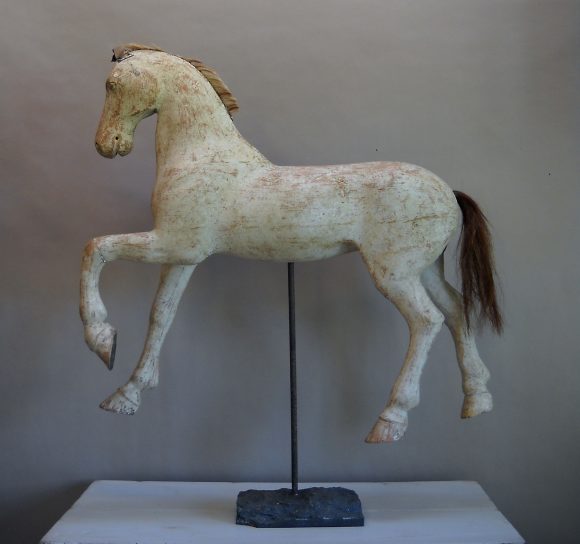+1 413-229-3070 | 800-290-5762 | edithgilson@cupboardsandroses.com
Horses & Other Creatures

Swedish horses – a national love affair
[caption id="attachment_5112" align="alignleft" width="240"]We love carved horses! As you can see, we usually have a small herd of toy horses here at Cupboards & Roses, along with other animals that catch our fancy. It’s lucky that Sweden loves the horse even more than we do.
 Skogsruss pony[/caption]
Skogsruss pony[/caption]
You simply can’t imagine the earliest settlements in cold Scandinavia succeeding without horses. As early as 4000 BC, horses were found in Sweden, but whether they were there for working or for dinner is unclear. Three thousand years later, horses were being used on farms as “living tools” throughout the region.
The original Scandinavian horse was small and high-spirited with good endurance, much like today’s Gotland Island pony, or skogsruss (horse of the woods).
Much later, in the sixteenth century, the Swedish king made the decision to improve the quality of the native horses and began a national breeding program. Friesians were imported from the Netherlands and used to develop a light draft horse, the North Swedish horse (nordsvenska brukshästen), for farmers and mounted soldiers. German Hanoverian stock was bred to native horses to breed the Swedish Warmblood, a riding and driving horse.
Toy Horses
 Horses were so important that they were virtually family members, and of course children played with horse toys. Viking children had homemade carved horses to play with, as well as with swords, ships, dolls, and farm animals.
Horses were so important that they were virtually family members, and of course children played with horse toys. Viking children had homemade carved horses to play with, as well as with swords, ships, dolls, and farm animals.
During the Middle Ages, stick horses and horses on wheels carried children into “battle.” By the sixteenth century, young soldiers were riding barrel horses made from a log with four legs and a crude head at the front.
By the 1800s, beautifully carved horses mounted on rockers or wheels had arrived. Made at home or in a toy factory, the horses were roughly shaped, then coated with gesso to provide a surface for paint. Ears might be made of leather, and horsehair was added for the mane and tail. Eyes might be glass, carved into the head, or simply painted on. The most dashing warhorses often had flaring, red-painted nostrils.
Dala Horses
[caption id="attachment_5115" align="alignleft" width="293"] Dala horses come in all sizes and colors.[/caption]
Dala horses come in all sizes and colors.[/caption]
No discussion of Swedish horses would be complete without mention of the Dalecarlian or Dala horse, a symbol of Sweden today.
The earliest farmers carved toys for their children during the long Swedish winters. By 1800, they were being sold or bartered for household necessities. While there were many carvers, there were only a few painters, and each village in Dalarna developed its own style.
Over time, one particular style emerged as the Dala horse we know: flat-plane carved with stocky form and painted bright red with details in white, green, yellow and blue.
At Cupboards & Roses Swedish Antiques, we search throughout Sweden for the most charming carved horses. Each has his own personality and shows the years of love he has enjoyed. Check back often to see the new members of our herd.